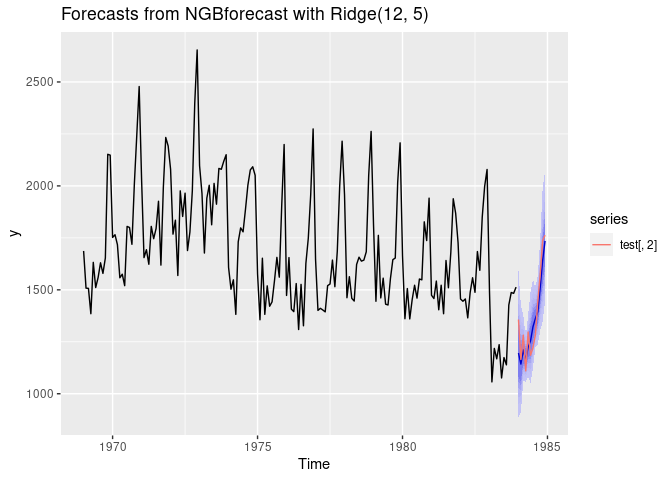
The hardware and bandwidth for this mirror is donated by dogado GmbH, the Webhosting and Full Service-Cloud Provider. Check out our Wordpress Tutorial.
If you wish to report a bug, or if you are interested in having us mirror your free-software or open-source project, please feel free to contact us at mirror[@]dogado.de.
The goal of ngboostForecast is to provide a tools for probabilistic forecasting by using Python’s ngboost for R users.
You can install the released version of ngboostForecast from CRAN with:
install.packages("ngboostForecast")And the development version from GitHub with:
# install.packages("devtools")
devtools::install_github("Akai01/ngboostForecast")This is a basic example which shows you how to solve a common problem:
library(ngboostForecast)
#> Loading required package: reticulate
#> Registered S3 method overwritten by 'quantmod':
#> method from
#> as.zoo.data.frame zoo
train = window(seatbelts, end = c(1983,12))
test = window(seatbelts, start = c(1984,1))
# without external variables with Ridge regression
model <- NGBforecast$new(Dist = Dist("LogNormal"),
Base = sklearner(module = "linear_model",
class = "Ridge"),
Score = Scores("LogScore"),
natural_gradient = TRUE,
n_estimators = 200,
learning_rate = 0.1,
minibatch_frac = 1,
col_sample = 1,
verbose = TRUE,
verbose_eval = 5,
tol = 1e-5)
model$fit(y = train[,2],
seasonal = TRUE,
max_lag = 12,
early_stopping_rounds = 10L)
fc <- model$forecast(h = 12, level = c(99,95,90, 80, 70, 60),
data_frame = FALSE)
autoplot(fc) + autolayer(test[,2])
library(ngboostForecast)
dists <- list(Dist("Normal"))
base_learners <- list(sklearner(module = "tree", class = "DecisionTreeRegressor",
max_depth = 1),
sklearner(module = "tree", class = "DecisionTreeRegressor",
max_depth = 2),
sklearner(module = "tree", class = "DecisionTreeRegressor",
max_depth = 3),
sklearner(module = "tree", class = "DecisionTreeRegressor",
max_depth = 4),
sklearner(module = "tree", class = "DecisionTreeRegressor",
max_depth = 5),
sklearner(module = "tree", class = "DecisionTreeRegressor",
max_depth = 6),
sklearner(module = "tree", class = "DecisionTreeRegressor",
max_depth = 7))
scores <- list(Scores("LogScore"))
model <- NGBforecastCV$new(Dist = dists,
Base = base_learners,
Score = scores,
natural_gradient = TRUE,
n_estimators = list(10, 100),
learning_rate = list(0.1, 0.2),
minibatch_frac = list(0.1, 1),
col_sample = list(0.3),
verbose = FALSE,
verbose_eval = 100,
tol = 1e-5)params <- model$tune(y = AirPassengers,
seasonal = TRUE,
max_lag = 12,
xreg = NULL,
early_stopping_rounds = NULL,
n_splits = 4L)params
#> $ngboost_best_params
#> $ngboost_best_params$Base
#> DecisionTreeRegressor(max_depth=7.0)
#>
#> $ngboost_best_params$Dist
#> <class 'ngboost.distns.normal.Normal'>
#>
#> $ngboost_best_params$Score
#> <class 'ngboost.scores.LogScore'>
#>
#> $ngboost_best_params$col_sample
#> [1] 0.3
#>
#> $ngboost_best_params$learning_rate
#> [1] 0.2
#>
#> $ngboost_best_params$minibatch_frac
#> [1] 1
#>
#> $ngboost_best_params$n_estimators
#> [1] 100
#>
#>
#> $ngb_forecast_params
#> $ngb_forecast_params$seasonal
#> [1] TRUE
#>
#> $ngb_forecast_params$max_lag
#> [1] 12
#>
#> $ngb_forecast_params$K
#> [1] 5These binaries (installable software) and packages are in development.
They may not be fully stable and should be used with caution. We make no claims about them.
Health stats visible at Monitor.